
A nebula is a distinct luminescent part of interstellar medium, which can consist of ionized, neutral, or molecular hydrogen and also cosmic dust. Nebulae are often star-forming regions, such as in the "Pillars of Creation" in the Eagle Nebula. In these regions, the formations of gas, dust, and other materials "clump" together to form denser regions, which attract further matter and eventually become dense enough to form stars. The remaining material is then thought to form planets and other planetary system objects.

A planetary nebula is a type of emission nebula consisting of an expanding, glowing shell of ionized gas ejected from red giant stars late in their lives.

The Ring Nebula is a planetary nebula in the northern constellation of Lyra.[C] Such a nebula is formed when a star, during the last stages of its evolution before becoming a white dwarf, expels a vast luminous envelope of ionized gas into the surrounding interstellar space.

The Helix Nebula is a planetary nebula (PN) located in the constellation Aquarius. Discovered by Karl Ludwig Harding, most likely before 1824, this object is one of the closest of all the bright planetary nebulae to Earth. The distance, measured by the Gaia mission, is 655±13 light-years. It is similar in appearance to the Cat's Eye Nebula and the Ring Nebula, whose size, age, and physical characteristics are similar to the Dumbbell Nebula, varying only in its relative proximity and the appearance from the equatorial viewing angle. The Helix Nebula has sometimes been referred to as the "Eye of God" in pop culture, as well as the "Eye of Sauron".

The Eskimo Nebula, also known as the Clown-faced Nebula, Lion Nebula, or Caldwell 39, is a bipolar double-shell planetary nebula (PN). It was discovered by astronomer William Herschel in 1787. The formation resembles a person's head surrounded by a parka hood. It is surrounded by gas that composed the outer layers of a Sun-like star. The visible inner filaments are ejected by a strong wind of particles from the central star. The outer disk contains unusual, light-year-long filaments.

The Little Dumbbell Nebula, also known as Messier 76, NGC 650/651, the Barbell Nebula, or the Cork Nebula, is a planetary nebula in the northern constellation of Perseus. It was discovered by Pierre Méchain in 1780 and included in Charles Messier's catalog of comet-like objects as number 76. It was first classified as a planetary nebula in 1918 by the astronomer Heber Doust Curtis. However, others might have previously recognized it as a planetary nebula; for example, William Huggins found its spectrum indicated it was a nebula ; and Isaac Roberts in 1891 suggested that M76 might be similar to the Ring Nebula (M57), as seen instead from the side view.
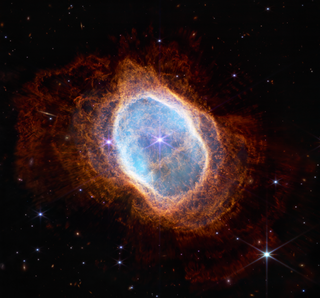
NGC 3132 is a bright and extensively studied planetary nebula in the constellation Vela. Its distance from Earth is estimated at about 613 pc or 2,000 light-years.

The Medusa Nebula is a planetary nebula in the constellation of Gemini. It is also known as Abell 21 and Sharpless 2-274. It was originally discovered in 1955 by University of California, Los Angeles astronomer George O. Abell, who classified it as an old planetary nebula.. With the computation of expansion velocities and the thermal character of the radio emission, Soviet astronomers in 1971 concluded that it was most likely a planetary nebula. As the nebula is so large, its surface brightness is very low, with surface magnitudes of between +15.99 and +25 reported.

Abell 39 is a low surface brightness planetary nebula in the constellation of Hercules. It is the 39th entry in George Abell's 1966 Abell Catalog of Planetary Nebulae of 86 old planetary nebulae which either Abell or Albert George Wilson discovered before August 1955 as part of the National Geographic Society - Palomar Observatory Sky Survey. It is estimated to be about 3,800 light-years from earth and thus 2,600 light-years above the Galactic plane. It is almost perfectly spherical and also one of the largest known spheres with a radius of about 1.4 light-years.
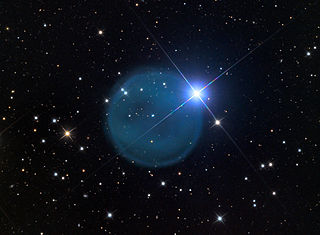
Abell 33 is a faint spherical planetary nebula located 2700 light years away in the constellation of Hydra. It lies just behind the star HD 83535 which has no relation to the nebula. The star HD 83535 is also responsible for the "diamond ring" effect seen in the photograph.

Abell 31 is an ancient planetary nebula in the constellation of Cancer. It is estimated to be about 2,000 light years away. Although it is one of the largest planetary nebulae in the sky, it is not very bright. The central star of the planetary nebula is a white dwarf with a spectral type of DAO. The white dwarf is the dead remains of a star that existed but had died leaving behind Abell 31 and the white dwarf.

Abell 70 is a planetary nebula located 13,500-17,500 light years away in the constellation of Aquila. It is approaching the earth at 79 kilometers per second and expanding 38 kilometers per second. There is a galaxy named PMN J2033-0656 behind Abell 70, giving it a "diamond ring" effect.
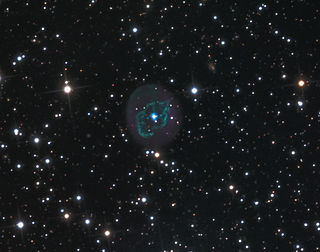
Abell 78 is a planetary nebula located in the constellation of Cygnus. It has a fainter halo consisting mostly hydrogen, and an inner elliptical ring that is mostly made of helium.
Abell 7 is a faint planetary nebula located 1800 light-years away in the constellation of Lepus. It has a generally spherical shape about 8 light-years in diameter. Within the sphere are complex details that are brought out by narrowband filters. Abell 7 is estimated to be only 20,000 years old, but the central star, a fading white dwarf, is estimated to be some 10 billion years old.
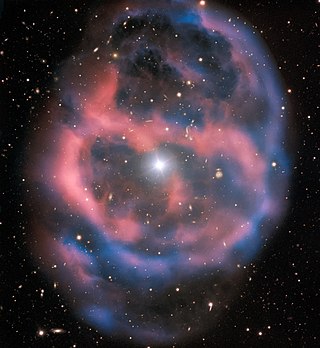
Abell 36 is a planetary nebula located 780 light years away in the constellation of Virgo.
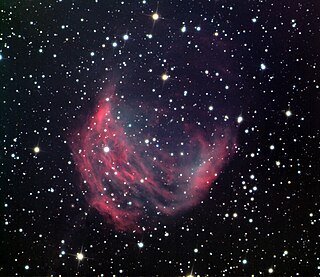
The Abell Catalog of Planetary Nebulae was created in 1966 by George O. Abell and was composed of 86 entries thought to be planetary nebulae that were collected from discoveries, about half by Albert George Wilson and the rest by Abell, Robert George Harrington, and Rudolph Minkowski. All were discovered before August 1955 as part of the National Geographic Society – Palomar Observatory Sky Survey on photographic plates created with the 48-inch (1.2 m) Samuel Oschin telescope at Mount Palomar. Four are better known from previous catalogs: Abell 50 is NGC 6742, Abell 75 is NGC 7076, Abell 37 is IC 972, and Abell 81 is IC 1454. Another four were later rejected as not being planetaries: Abell 11, Abell 32, Abell 76, and Abell 85. Another three were also not included in the Strasbourg-ESO Catalogue of Galactic Planetary Nebulae (SEC): Abell 9, Abell 17, and Abell 64. Planetaries on the list are best viewed with a large aperture telescope and an OIII filter.

Abell 63 is a planetary nebula with an eclipsing binary central star system in the northern constellation of Sagitta. Based on parallax measurements of the central star, it is located at a distance of approximately 8,810 light years from the Sun. The systemic radial velocity of the nebula is +41±2 km/s. The nuclear star system is the progenitor of the nebula and it has a combined apparent visual magnitude of 14.67. During mid eclipse the magnitude drops to 19.24.

Abell 48 is a planetary nebula likely located around 14,000 light years away in the constellation of Aquila. It is noteworthy among planetary nebulae for hosting a rare WN-type Wolf-Rayet-type central star, a [WN4]-type star, which was once thought to be a bona-fide Wolf-Rayet star, and received the name WR 120–6. The nebula is made up of two rings surrounding the central star, and is heavily reddened, with an E(B-V) value of 2.14 and a visual extinction of 6.634 magnitudes, which is why it appears so dim.

















